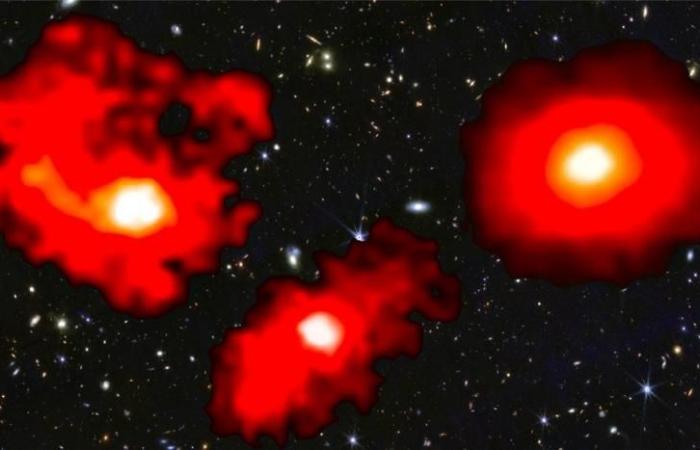Three galactic “red monsters” have been discovered in the early Universe by an international team led by UNIGE. Their measurement indicates that star genesis in the early Universe was much more efficient than scientists thought. Existing models of galaxy formation probably need to be reviewed.
Try to imagine the immense mass of our Milky Way: it is made up of between 200 and 400 billion stars spread over a diameter of just over 100,000 light years. And it is ancient, being 13.6 billion years old.
The surprising discovery of the team of astrophysicists is three galaxies present in the first billion years after the Big Bang – an event which took place 13.8 billion years ago. Those which have been nicknamed “red monsters” are ten times smaller than our galaxy while having a stellar mass comparable to that of the current Milky Way!
They were spotted thanks to the FRESCO program of the James Webb Space Telescope (JWST): it is their high dust content which gives them this distinct glowing color on the images taken by the NIRCam/grism spectrograph.
>> About the FRESCO program: Behind the scenes of James Webb Space Telescope data
Observations that shake up theory
These galaxies form stars almost twice as efficiently as their lower mass counterparts and older galaxies. Enough to call into question the theory favored by scientists which wants galaxies to form gradually: “The vast halos of dark matter capture the gas – atoms and molecules – to make structures linked by gravitation. As a general rule, only 20% of this gas is converted into stars in galaxies,” explains the University of Geneva in a press release.
>> Read also: The first star clusters helped shape galaxies at the cosmic dawn
Scientists are finding more and more massive galaxies in the early Universe. Too much compared to predictions. “We discover some a billion years after the Big Bang, but also very luminous and massive ones in the even more distant Universe,” remarks Pascal Oesch, associate professor in the Department of Astronomy of the Faculty of Sciences of the UNIGE, principal investigator of the observation program. “In general, galaxies are expanding more quickly than we thought,” he tells RTSinfo.
The reason for this phenomenon is not yet known: “The simplest theory to explain it is that the gas was denser in the ancient Universe and that stars formed more quickly. We will having to change the ingredients of our simulations to model more efficient star formation and understand it,” he adds.
New measures
From now on, the astrophysicist and his team will observe the three red monsters again to independently measure their mass with the NIRspec, a JWST spectrograph: “With its detailed spectra, it will make it possible to estimate the mass thanks to gravitation”. And Pascal Oesch is delighted: “We will also be able to find more galaxies of this type with the Euclid telescope and thus test new hypotheses.”
>> Read also: Euclid will challenge Einstein’s general relativity
Future observations from JWST and the Atacama Large Millimeter Array (ALMA) will also allow us to learn more about these ultra-massive galaxies. L’study was published in Nature on Wednesday.
Stéphanie Jaquet






